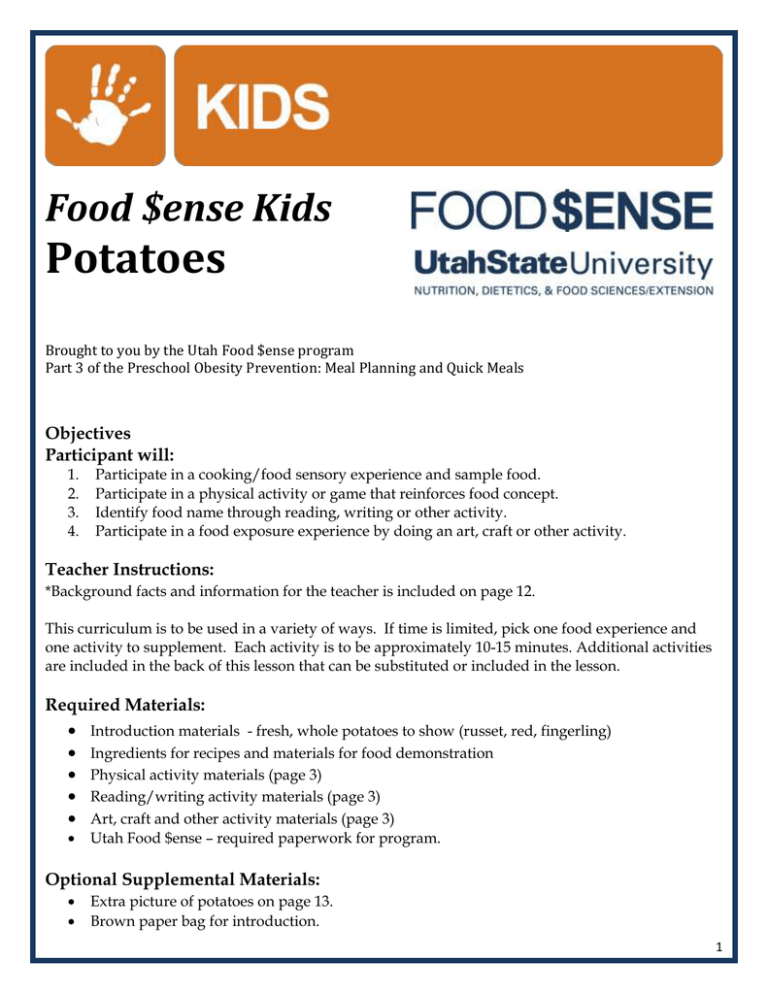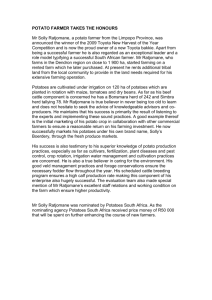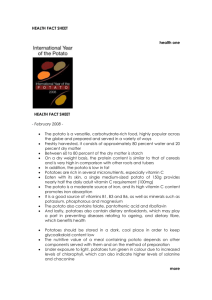Potatoes Food $ense Kids
advertisement

Food $ense Kids Potatoes Brought to you by the Utah Food $ense program Part 3 of the Preschool Obesity Prevention: Meal Planning and Quick Meals Objectives Participant will: 1. 2. 3. 4. Participate in a cooking/food sensory experience and sample food. Participate in a physical activity or game that reinforces food concept. Identify food name through reading, writing or other activity. Participate in a food exposure experience by doing an art, craft or other activity. Teacher Instructions: *Background facts and information for the teacher is included on page 12. This curriculum is to be used in a variety of ways. If time is limited, pick one food experience and one activity to supplement. Each activity is to be approximately 10-15 minutes. Additional activities are included in the back of this lesson that can be substituted or included in the lesson. Required Materials: Introduction materials - fresh, whole potatoes to show (russet, red, fingerling) Ingredients for recipes and materials for food demonstration Physical activity materials (page 3) Reading/writing activity materials (page 3) Art, craft and other activity materials (page 3) Utah Food $ense – required paperwork for program. Optional Supplemental Materials: Extra picture of potatoes on page 13. Brown paper bag for introduction. 1 Preparation Required: Review lesson plan. Review teacher background information. Gather ingredients and materials needed to demonstrate the recipes (see page 4 ). Make copies of potato book pages for each child and cut them to size (page 3, 7-10). Make copies of take home handout with recipes you wish to distribute – enough for all class participants to take home to families. Make copies of all required paperwork for lesson. LESSON PLAN Introduction Time: 5 minutes Bring a russet, red, and fingerling potato and choose one to put in a brown paper bag. Choose a student to come up and feel inside of the bag to try and tell what food is in the bag. Have them explain what they feel (is it squishy, firm, rough, smooth?) Then have the child pull it out and show the class, they can then pass it around. -What colors are potatoes? Explain they can be brown, red, white, yellow, and blue/purple -What shape are they? -What foods can you make with potatoes? How have they eaten potatoes? Mashed, roasted, French fries, potato chips, potato salad, hash browns, soup, -How do potatoes grow? (show pictures on pages 5-6) Potatoes are called tubers. They grow underground on the roots of a plant; above ground you see a green leafy plant with white flowers. -Are potatoes good for us? Potatoes have lots of vitamins and minerals that help our bodies be healthy and strong! Objective 1: Participate in a cooking/ food sensory experience and sample food. Time: 15 minutes Choose a recipe that will work for your lesson (see page 4) : o Potato Soup o Oven Potato Wedges o Simple Stuffed Potatoes Objective 2: Participate in a physical activity or game that reinforces food concept. Time: 5-10 minutes “Hot Potato” To do this activity: -Have the children sit in a circle. -Pass a russet or red potato around the circle while playing music. -Periodically stop the music, and the child who has the potato when it stops is out. -The last child is the hot potato! 2 Note: If you do not have a music player, the teacher can sing a familiar song. Objective 3: Identify food name through reading, writing or other activity. Time: 10-15 minutes Potato Counting Book To do this activity: You can have the potato book pages (pg. 7-10) already cut out, or you can have each child cut out their own. Each child can color their pages. Staple them together to create their own potato counting book! o “One potato, two potatoes, three potatoes, four. Five potatoes, six potatoes, I want to count some more.” Objective 4: Participate in a food exposure experience by doing and art, craft, or other activity. Time: 5 -10 minutes Potato Coloring Page (pg.11) Conclusion: Time: 5 minutes Ask the class: What things did you learn about potatoes today? What colors can potatoes be ? How do potatoes grow? Are potatoes good for us ? How can you eat potatoes ? Resources : http://www.craftjr.com/printable-bubble-letters/ http://www.makinglearningfun.com/themepages/StPatricksDayPotatoCountBook.htm http://www.idahopotato.com/downloads/PPNHandbook_Final.pdf This material was funded by USDA’s Supplemental Nutrition Assistance Program – SNAP. The Supplemental Nutrition Assistance Program (SNAP) provides nutrition assistance to people with low income. It can help you buy nutritious foods for a better diet. To find out more, contact 1-800-221- 3 5689 or visit online at http://www.fns.usda.gov/snap/. In accordance with Federal Law and U.S. Department of Agriculture policy, this institution is prohibited from discriminating on the basis of race, color, national origin, sex, age, religion, political beliefs or disability. To file a complaint of discrimination, write USDA, Director, Office of Civil Rights, 1400 Independence Avenue, S.W., Washington, D.C. 202509410 or call (800)795- RECIPES Topic: Potatoes Red Potato Salad Ingredients: 12 cups cubed red potatoes 1 cup chopped green bell pepper (about 1 medium) 1/2 cup minced red onion 1/2 cup extra-virgin olive oil 1/3 cup red wine vinegar 2 tablespoons Dijon mustard 2 tablespoons mayonnaise 1 1/2 teaspoons salt 1/2 teaspoon ground black pepper Directions: Cook potatoes, covered in boiling water, 10 minutes, or until tender; drain well and cool. In a large bowl, combine potatoes, bell pepper and onion. In a small bowl, whisk together remaining ingredients. Pour over potato mixture, tossing gently to coat. Cover and refrigerate. Oven Potato Wedges Ingredients: 2 lb. Red Potatoes, cut into small wedges 1 Onion, chopped 3 T. Olive Oil 1 tsp. Garlic Powder ½ tsp. Salt ¼ tsp. Oregano Directions: Combine all ingredients; stir to coat. Place in ungreased baking pan. Bake at 425 degrees for 30-35 minutes, or until potatoes are tender. Simple Stuffed Potatoes Ingredients: 1 tsp. Butter 2 C. Mashed potatoes 1 C. cubed Ham ½ C. green onions ½ C. shredded Cheddar Cheese Directions: In large bowl, combine mashed potatoes, butter, ham and green onions. Sprinkle with cheese. ___________________________________________________________________ 4 This material was funded by USDA’s Supplemental Nutrition Assistance Program – SNAP. The Supplemental Nutrition Assistance Program (SNAP) provides nutrition assistance to people with low income. It can help you buy nutritious foods for a better diet. To find out more, contact 1-800-221-5689 or visit online at http://www.fns.usda.gov/snap/. In accordance with Federal Law and U.S. Department of Agriculture policy, this institution is prohibited from discriminating on the basis of race, color, national origin, sex, age, religion, political beliefs or disability. To file a complaint of discrimination, write USDA, Director, Office of Civil Rights, 1400 Independence Avenue, S.W., Washington, D.C. 20250-9410 or call (800)795-3572. 5 http://whatelylandpreservation.org/wandwandwykowski.html 6 7 8 9 10 11 Preschool Curriculum Potatoes Background Teaching Information History: -The cultivation of potatoes is believed to date back to 500 B.C. -Today, roots and tubers are the third largest carbohydrate food source, with potatoes representing nearly half of all root crops consumed (FAO/WHO report 1998). Potatoes are grown in all 50 states of the U.S. and in about 125 countries throughout the world, and they continue to be valued for their durability and the fact that they are nutrient rich. Potatoes have long held the prominent position of being America’s favorite vegetable, and in 2008, 79% of American’s consumed potatoes in-home 3.4 times in the average two-week period. -Potatoes come in many varieties including russets (the most widely used variety in the US), reds, whites, yellows, fingerlings, and blues/purples. Nutrition: Potatoes are a great source of potassium, Vitamin C, and fiber. One medium potato with the skin contains 45 percent of the daily value for vitamin C and as much or more potassium than bananas, spinach, or broccoli. Although potatoes do not rival the vitamin C content of citrus fruits and peppers, they do contribute significantly to the American’s daily vitamin C requirements. Potatoes provide one of the most concentrated sources of potassium — significantly higher than those foods commonly associated with potassium content (e.g., bananas, oranges, mushrooms, etc.). One medium potato with the skin contributes eight percent of the daily value for fiber. Dietary fiber is a complex carbohydrate and is the part of the plant material that cannot be digested and absorbed in the bloodstream. Dietary fiber has been shown to have numerous health benefits, including improving blood lipid levels, regulating blood glucose, and increasing satiety, which may help with weight loss. A common misconception is that all of the potato’s nutrients are found in the skin. While the skin does contain approximately half of the total dietary fiber, the majority (> 50 percent) of the nutrients are found within the potato itself. Selection and Storage: Look for clean, smooth, firm-textured potatoes with no cuts, bruises or discoloration. Store potatoes in a well-ventilated place, optimally at a temperature between 45°F and 55°F. Colder temperatures (as in a refrigerator) cause a potato’s starch to convert to sugar, resulting in a sweet taste and discoloration when cooked. If you do refrigerate, letting the potato warm gradually to room temperature before cooking can reduce the discoloration. Avoid areas that reach high temperatures (beneath the sink or beside large appliances) or receive too much sunlight (on the countertop near a window). Perforated plastic bags and paper bags offer the best environment for extending shelf-life. Don’t wash potatoes (or any produce for that matter) before storing. Dampness promotes early spoill This material was funded by USDA’s Supplemental Nutrition Assistance Program – SNAP. The Supplemental Nutrition Assistance Program (SNAP) provides nutrition assistance to people with low income. It can help you buy nutritious foods for a better diet. To find out more, contact 1-800-221-5689 or visit online at http://www.fns.usda.gov/snap/. In accordance with Federal Law and U.S. Department of Agriculture policy, this institution is prohibited from discriminating on the basis of race, color, national origin, sex, age, religion, political beliefs or disability. To file a complaint of discrimination, write USDA, Director, Office of Civil Rights, 1400 Independence Avenue, S.W., Washington, D.C. 20250-9410 or call (800)795- 12 POTATOES DID YOU KNOW? Potatoes are a great source of potassium, Vitamin C, and fiber. A common misconception is that all of the potato’s nutrients are found in the skin. While the skin does contain approximately half of the total dietary fiber, the majority (> 50 percent) of the nutrients are found within the potato itself. This material was funded by USDA’s Supplemental Nutrition Assistance Program – SNAP. The Supplemental Nutrition Assistance Program (SNAP) provides nutrition assistance to people with low income. It can help you buy nutritious foods for a better diet. To find out more, contact 1-800-221-5689 or visit online at http://www.fns.usda.gov/snap/. In accordance with Federal Law and U.S. Department of Agriculture policy, this institution is prohibited from discriminating on the basis of race, color, national origin, sex, age, religion, political beliefs or disability. To file a complaint of discrimination, write USDA, Director, Office of Civil Rights, 1400 Independence Avenue, S.W., Washington, D.C. 20250-9410 or call (800)795 13


